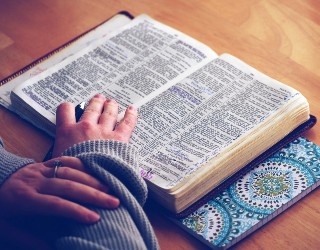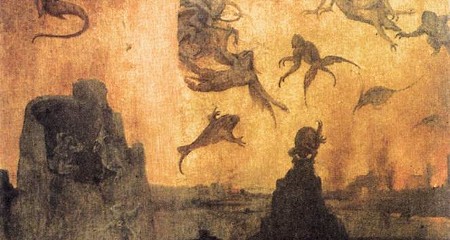We ask you, urgently: don’t scroll past this
Dear readers, Catholic Online was de-platformed by Shopify for our pro-life beliefs. They shut down our Catholic Online, Catholic Online School, Prayer Candles, and Catholic Online Learning Resources—essential faith tools serving over 1.4 million students and millions of families worldwide. Our founders, now in their 70's, just gave their entire life savings to protect this mission. But fewer than 2% of readers donate. If everyone gave just $5, the cost of a coffee, we could rebuild stronger and keep Catholic education free for all. Stand with us in faith. Thank you.Help Now >
Contemplating a Woman of Consequence: The Sistine Chapel on the Charles
FREE Catholic Classes
Regrettably, my time with this image of our beautiful Mother must end, and Sargent's Pieta speaks with one parting message: "See what my womb has borne. Eat, my child, and live." Our eyes locked, I nod and note: One cannot pass through her gates without emerging unchanged. She is, after all, a woman of consequence.
Highlights
Catholic Online (https://www.catholic.org)
5/28/2012 (1 decade ago)
Published in Living Faith
P>BOSTON, MA (Catholic Online) - As with many journeys of consequence, this one begins in darkness.
Tunneling through the glacial till of Shawmut Peninsula, Boston's subway line from Park Street to Copley Square is the city's oldest. Completed in 1898, it connects the legislative center on Beacon Hill to what was at the time, the city's newly created cultural hub.
Revered institutions encircled the square - institutions such as the Museum of Fine Arts, MIT, Trinity Church - HH Richardson's glorious pile of stained glass and Roxbury puddingstone, the Boston Art Club, and my destination - the Boston Public Library. The first two have since moved from their birthplace, but the others remain, still nobly gracing the square. Emerging from the subway, I look quickly over my shoulder to glance in admiration at the soaring Italianate campanile of the New Old South Church.
Across the street from my momentarily diverted attention is Boston's "palace for the people," its grande dame of architecture, its public library. Designed by Charles McKim and completed in 1895, she comfortably reigns over Copley Square. Well proportioned, handsomely clad, and tastefully ornamented, she is confident but not prideful. From her north facing limestone cornice, she speaks: "The Commonwealth Requires the Education of the People as the Safeguard of Order and Liberty."
The entrance is flanked by two imposing ladies in bronze. Sculpted by Bela Pratt in 1911, Science guards the southern flank and Art the northern. These stately women, robed and hooded, turn their gaze toward but not at those wishing to enter. Sitting upon their respective bronze thrones, their arms are open, a sign of welcome, but their knees are together and angled toward each other, and thus their demeanor suggests that they wish you to admire their trade but do not invite you to engage. As sentries, their efforts are inconsequential.
Nodding as I pass between them, my attempts at making eye contact with the pair are thwarted by their inward focus. They distractedly allow my entry into the building, and I find that this "palace" does not disappoint. I am engulfed in the warm glow of Iowa sandstone; the floor is white Georgia marble inlaid with symbols of the zodiac; and the ceiling is a wonder of mosaic clad domes. A pair of regal (and requisite) lions, sculpted by Saint-Gaudens, beckons bibliophiles upward.
The grand marble staircase is a memorial to the Commonwealth's Civil War infantry regiments, and ascending this noble memorial is a pleasure of motion honoring our veterans well. The memorial completes its ascent at the Puvis de Chavannes Gallery which serves as a foyer to Bates Hall, the library's magnificent reading room, but I'm continuing upward to the 3rd floor which houses special collections.
Ascending again, this time up a dimly lit limestone canyon, I lazily run my fingers along the smooth marble handrail, admiring the craftsmanship and wondering where have all the craftsmen gone; artistry is integral to every facet of this product of public munificence.
A quick glance upward to add confidence to footfall, and I am suddenly brought out of my reverie by the sight of something so unexpected, so utterly anathema to our current cultural norms, so utterly scandalous even to think of attempting in this day and age, and so utterly beautiful.
Mounted in the southern apex of a vast barrel-vaulted hall is the unmistakable form of our Lord upon His cross. Am I really seeing capital-H Him in the Boston Public Library? I have been known to walk into door jambs; could I have stumbled along the way, banging my head on the cold stone stair treads? Wherefore this marriage of the sacred and the profane?
Drawn as we are by His saving form, I hasten to the foot of the discovery, and looking around I find myself surrounded by the history of our faith. A quick lap of the space is all that is needed to discern that the murals are painted as a sequence, and the hand of the artist is readily identified as the distinct style of John Singer Sargent. In art school, I had an unabashed boyish crush on his most famous progeny, Madame X. But this masterpiece was never mentioned during five years of higher education.
Sargent's sequence begins on the wall opposite to my arrival. On the north wall of this veritable Sistine Chapel on the Charles is a depiction of the Israel under Egyptian oppression, pagan gods looming in the vault above. In the frieze below are the Old Testament prophets who, split into two symmetrical groups, provide balance on either side of Moses bearing the Ten Commandments.
The south wall is set up similarly. Our aforementioned Lord and Savior mirrors the figure of Israel on the opposing wall. Behind the Crucifix is the Trinity, and below, the frieze depicts angels, who in contrast to the anxiety and fear shown in the faces of the prophets, are calm and serene, possessing a powerful dignity, each bearing an instrument of Christ's passion. On the vault above are images of the mysteries of the rosary.
Between these two counterpoised walls are painted the Fall of Gog and Magog, Israel and the Law, Heaven, Hell, Judgment, Synagogue, and Church. It is the last of which that has captured my attention for there is a curious harkening to my two bronze female friends mentioned earlier.
Church is aptly painted as a female figure. She is seated in front the four symbols of the Gospel writers. She, like Pratt's Science and Art, is robed and hooded and reigns upon a similarly shaped thrown. However, with composed confidence our Lady stares directly at us. Her body is oriented to the viewer with her knees apart. This is a Pieta unlike any that I have seen; for the lifeless body of our crucified Lord, His arms draped over her thighs, hangs between her legs and not upon her lap, an unambiguous reference to a new nativity. Franciscans will note His body forms a perfect Tau. Their garments are painted as one continuous flowing form. They are cloaked inseparably.
In final contrast to the library's sentries, Church invites us to participate. With maternal love, she enfolds herself around Jesus' lifeless flesh, but she is not in mourning. In her right hand, she extends a chalice, in her left a monstrance. Formed in plaster for three-dimensional relief and painted in brilliant gold, these objects literally emerge from the wall. The Spirit of our Lord is clearly alive in these gifts being offered to us.
Regrettably, my time with this image of our beautiful Mother must end, and Sargent's Pieta speaks with one parting message: "See what my womb has borne. Eat, my child, and live." Our eyes locked, I nod and note: One cannot pass through her gates without emerging unchanged. She is, after all, a woman of consequence.
---
'Help Give every Student and Teacher FREE resources for a world-class Moral Catholic Education'
Copyright 2021 - Distributed by Catholic Online
Join the Movement
When you sign up below, you don't just join an email list - you're joining an entire movement for Free world class Catholic education.
-

-
Mysteries of the Rosary
-
St. Faustina Kowalska
-
Litany of the Blessed Virgin Mary
-
Saint of the Day for Wednesday, Oct 4th, 2023
-
Popular Saints
-
St. Francis of Assisi
-
Bible
-
Female / Women Saints
-
7 Morning Prayers you need to get your day started with God
-
Litany of the Blessed Virgin Mary
5 Biblical Warnings We All Must Heed
-

WHAT WILL IT TAKE? | Bishop Strickland Calls Out Silent Bishops in Strong Public Letter
-

Giants of the Fallen: Unveiling the Mystery of the Nephilim from a Catholic Perspective
-
Ancient Wisdom, Modern Choices: How Ecclesiastes 10:2 Illuminates Today's Political Divide
-
How Do We Know Truth? A Catholic Perspective
Daily Catholic
 Daily Readings for Saturday, November 16, 2024
Daily Readings for Saturday, November 16, 2024 St. Margaret of Scotland: Saint of the Day for Saturday, November 16, 2024
St. Margaret of Scotland: Saint of the Day for Saturday, November 16, 2024 Prayer for Life: Prayer of the Day for Saturday, November 16, 2024
Prayer for Life: Prayer of the Day for Saturday, November 16, 2024- Daily Readings for Friday, November 15, 2024
- St. Albert the Great: Saint of the Day for Friday, November 15, 2024
- To the Holy Spirit: Prayer of the Day for Friday, November 15, 2024
![]()
Copyright 2024 Catholic Online. All materials contained on this site, whether written, audible or visual are the exclusive property of Catholic Online and are protected under U.S. and International copyright laws, © Copyright 2024 Catholic Online. Any unauthorized use, without prior written consent of Catholic Online is strictly forbidden and prohibited.
Catholic Online is a Project of Your Catholic Voice Foundation, a Not-for-Profit Corporation. Your Catholic Voice Foundation has been granted a recognition of tax exemption under Section 501(c)(3) of the Internal Revenue Code. Federal Tax Identification Number: 81-0596847. Your gift is tax-deductible as allowed by law.






 Daily Readings for Saturday, November 16, 2024
Daily Readings for Saturday, November 16, 2024 St. Margaret of Scotland: Saint of the Day for Saturday, November 16, 2024
St. Margaret of Scotland: Saint of the Day for Saturday, November 16, 2024 Prayer for Life: Prayer of the Day for Saturday, November 16, 2024
Prayer for Life: Prayer of the Day for Saturday, November 16, 2024


